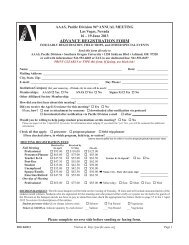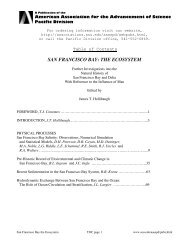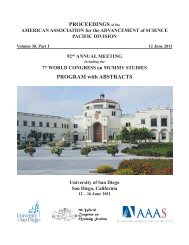Vol 31, Part I - forums.sou.edu ⢠Index page - Southern Oregon ...
Vol 31, Part I - forums.sou.edu ⢠Index page - Southern Oregon ...
Vol 31, Part I - forums.sou.edu ⢠Index page - Southern Oregon ...
You also want an ePaper? Increase the reach of your titles
YUMPU automatically turns print PDFs into web optimized ePapers that Google loves.
ABSTRACTS – Contributed Posters<br />
161 The Impact of Traffic and Heavy Vehicles on Air quality:<br />
A Case Study in Portland, <strong>Oregon</strong>, ADILENE AMARO-<br />
ZURITA (Department of Civil Engineering, Portland State<br />
University, Engineering Building Suite 200, 1930 SW 4th<br />
Ave. Portland, OR 97201; ceedept@cecs.pdx.<strong>edu</strong>).<br />
Air quality in traffic corridors are affected by traffic<br />
volumes and the types of vehicles used. Persons that use these<br />
corridors as public transit users, pedestrians, and cyclists are<br />
exposed to air pollutants that can adversely affect human<br />
health such as particulate matter, carbon monoxide, and carbon<br />
dioxide. This case study is looking at the impacts of congestion,<br />
traffic volumes and weather variables on the levels of PM 2.5<br />
,<br />
PM 1<br />
, PM 10<br />
, and Ultrafine particles. <strong>Part</strong>iculate matter is fine<br />
particles that can be found in the air and smoke. Because of its<br />
microscopic size, it can pass through the nose, throat, and deep<br />
into the lungs and across the lungs into cardiovascular system<br />
and aggravate heart and lung diseases. The objective of this<br />
research is to try explain changes in level of PM 2.5<br />
, PM 1<br />
, PM 10<br />
,<br />
and Ultrafine particles as a function of traffic and weather<br />
variables. Some of the equipment used for data collection was:<br />
• The Wavetronix sensor, which is a radar unit, were used to<br />
measure traffic volumes of cars and heavy vehicles at the<br />
intersection.<br />
• Dustrak Aerosol monitors were used to measure particulate<br />
matter levels.<br />
• A Young Ultrasonic Anemometer Model 81000 was used to<br />
measure the wind speed and direction.<br />
The data indicate that PM 2.5<br />
levels can be highest during<br />
peak traffic periods (e.g. 9/15/2011 data) fairly steady in<br />
other days (e.g. 9/29/11). There seems to be a correlation<br />
between PM 2.5,<br />
PM 1<br />
, and PM 10<br />
levels, heavy vehicle traffic<br />
and wind speed.<br />
CELL and MOLECULAR BIOLOGY<br />
162 Tetracycline-Inducible Overexpression of Human<br />
Oncostatin M in Breast Cancer, DOLLIE LaJOIE* and<br />
CHERYL L JORCYK (Department of Biological Sciences,<br />
Boise State University, 1910 University Drive, Boise, ID<br />
83725; dollielajoie@boisestate.<strong>edu</strong>, cjorcyk@boisestate.<strong>edu</strong>).<br />
Oncostatin M (OSM) is a signaling factor that binds to its<br />
receptors to induce various changes in breast cancer cell growth<br />
and metastasis. We are creating stable human breast cancer cell<br />
lines that will inducibly overexpress human OSM by lentiviral<br />
transduction. Confirmation of tetracycline-inducible OSM<br />
overexpression will be determined by ELISA. The cell lines will<br />
be further characterized in vitro. In vivo, these cells will allow<br />
us to evaluate the effects of OSM on breast cancer metastasis.<br />
Research supported by Susan G. Komen for the Cure (KG100513),<br />
American Cancer Society (RSG-09-276-01-CSM), INBRE (P20RR016454<br />
& P20GM103408).<br />
163 In Vitro Investigation of Cytokine-Induced<br />
Osteoclastogenesis by Mammary Tumor Cells, ERIK<br />
STOLL*, CELESTE BOLIN, and CHERYL JORCYK<br />
(Department of Biological Sciences, Boise State University,<br />
1910 University Drive, Boise, ID 83725).<br />
Breast cancer metastasis to bone often results in a<br />
pathological condition that can cause bone degradation and<br />
pain. These metastases disrupt normal bone homeostasis,<br />
which is regulated by bone forming osteoblasts and bone<br />
resorbing osteoclasts. In particular, breast cancer metastases<br />
promote the differentiation of preosteoclasts to mature<br />
osteoclasts during the process of osteoclastogenesis.<br />
Previous results from our lab have shown that an IL-6<br />
family cytokine member can promote osteoclastogenesis in in<br />
vitro models of breast cancer metastasis to bone. Specifically,<br />
we have shown that the mechanism of this cytokine-induced<br />
increased osteoclastogensis is through an increase in growth<br />
factor secretion by mammary tumor cells. These in vitro<br />
studies were performed with mouse mammary tumor cells in<br />
co-culture with mouse preosteoclast cells. To investigate the<br />
importance of tumor cell-secreted factors versus membrane<br />
bound factors on the promotion of osteoclastogenesis, we<br />
performed a transwell experiment in which mouse mammary<br />
cells were separated from mouse preosteoclast cells by a 0.4<br />
µm porous membrane. The mouse mammary cells were pretreated<br />
with a neutralizing antibody for growth factors of<br />
interest, and osteoclastogenesis was measured by tartrateresistant<br />
acid phosphatase (TRAP) staining, a marker for<br />
mature osteoclasts. Results from this study further our<br />
investigation on the importance of direct cell-to-cell contact<br />
in cytokine-induced osteoclastogenesis.<br />
Funding: NASA - NNX10AN29A; INBRE - (NIH/NCERR) – NIH/NCRR<br />
P20RR016454 and P20GM103408; Komen – KG100513; ACS – RSG-09-<br />
276-01-CSM<br />
164 The Effect of JMJD Inhibitors on Head and Neck<br />
Cancer Cell Proliferation, MARIA VIDAL* 1 , NAILAH<br />
WADE* 1 , DAVID BAE 2 , ERIC TANG 2 , CUN-YU WANG 2<br />
( 1 Howard Hughes Medical Institute Pre-College Science<br />
Education Program; 2 UCLA School of Dentistry, 10833<br />
Le Conte Avenue, 63-007 CHS, Los Angeles, CA 90095;<br />
mariavidal95@yahoo.com, nsolufemi@hotmail.com).<br />
Jumonji domain (JMJD) proteins can demethylate lysine<br />
or arginine residues on histones and have been found to play<br />
an important role in development and cancer.Objective: To<br />
examine how two JMJD2 inhibitors, A70 and SD70, affect<br />
proliferation of two established squamous cell carcinoma<br />
(SCC) cell lines SCC1 and SCC23. Methods: To determine<br />
effects on proliferation, proliferation assay was performed<br />
whereby SCC cell lines were grown on 6 well dishes with<br />
or without inhibitors and cell number was counted daily<br />
using a hemacytometer for four days. To analyze protein<br />
expression, western blot analysis was performed on cells<br />
from day four. To identify the progression of cell cycle<br />
upon treatment, we performed cell cycle analysis of SCC<br />
cell lines on day four. Results: Proliferation assay revealed<br />
that both JMJD2 inhibitors A70 and SD70 drastically<br />
95








